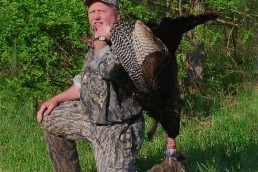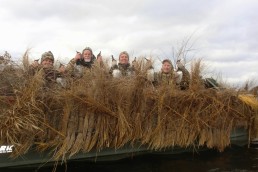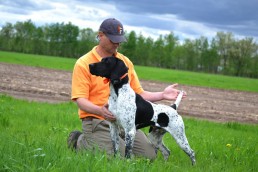No-call Turkey Hunting
SHARE THIS POST
During the earlier heyday of spring turkey hunting it wasn’t unusual for hunters to slip into rural habitats where wild turkeys resided, call a few times and see a gobbler run into shooting range. Many of us who hunted turkeys 30 years ago might have believed we were exceptional hunters whenever toms responded so quickly; it was as if they were trained to come to our calls. Unfortunately, it’s not that simple today because the birds are more wary than ever. Fortunately, I believe gobblers have become such exciting game that if every one were easy the challenge might just lose its appeal.
The synopsis for hunting spring gobblers has typically been based upon calling, and not necessarily the type or brand name call you use or sounds you create. Obviously, calling tools help produce results, but wise hunters should also rely upon “woodsmanship” afield, knowledge of turkey habits and familiarity with landscape and topography.
There are many calling devices on the market, and manufacturers are assuring hunters that a turkey call is required to call in a spring gobbler. Undoubtedly, calls set the stage for a rewarding hunt and calling a spring tom excites him into investigating your presence. But there are times when calling to a wary tom will only alarm him. If you don’t call, especially to a mature tom that’s heard numerous hunter-calling vocals, can you still tag one?
Silence can be golden, and there are schemes that can be used too fool a mate-minded turkey.
Gut instinct often saves a turkey hunter’s day, but, more important, it’s understanding turkey habitats and being familiar with their habitats that can also make you successful.
Whenever you believe you have a turkey hunt mastered, reality often changes your outcome. For example, I can still visualize an elusive gobbler trying to avoid me as he walk-strutted in a 180-degree circle in front of me. I had created my own obstacles that morning I shot my gobbler because I had left home without my hunting vest, which contained my calls. Call it stupidity or lack of preparation, but I had already walked one-half mile across the previous year’s unplowed cut bean field and had forced my body through dense underbrush and greenbrier. After a while afield, two toms were gobbling here. I would not leave the vocal duo to make the 20-minute drive back home for my calls because I couldn’t control my excitement.
That’s when I realized obstacles could force a hunter to be creative.
Are you enjoying this post?
You can be among the first to get the latest info on where to go, what to use and how to use it!
The best-laid plans aren’t always successful. In this hunt I was virtually call-less. But I was familiar with the landscape and habits of the turkeys. I believed my position was perfect—tucked into a dense tangle of greenbrier 80 yards below their roosts. I hadn’t heard any hens, but I used my instincts and knowledge of my environment and believed I would be near their “den.” Although I was pinned down, I was certain the toms couldn’t see my movements. I took a chance and raked leaves and broke small branches. When they gobbled I felt like a human predator. I tried calling the toms with my mouth, and no diaphragm call. It sound awful to me, but the toms didn’t care. They were interested? Yes—both toms approached to investigate my hen vocals and I shot one of the toms.
To understand turkey habits we must become intimately familiar with their home grounds. Consider your position, your concealment, and create no movement and use natural structures for that concealment.
The best part about hunting is that each hunter is an individual and can hunt their own way, but there are basic rules. That individuality, though, can often help hunters score. Whenever hunters are comfortable with their methods and skills, and the order or cadence they impart them, they are more productive and the results from this will further educate them and help build confidence.
Wild turkeys are curious and influenced by the structures throughout their habitats. But don’t be reluctant to create sounds these birds are familiar with like, raking leaves and debris, as this commotion is typical of a turkey feeding. Wing flapping is a natural sound created by turkeys on the move. You can also use your hat and beat it against your leg or arm to create this natural sound.
Experiment every day you hunt. Although it’s illegal to shoot turkeys from their tree roosts, after they pitch off their aerial bedding perch, their wing beats are very noticeable. Why not create your own fly-down commotion at daybreak? Nearby gobblers will hear your mimicking sounds and focus upon you. And, hopefully, a tom will think you’re a hen below.
It’s natural for hens to preen their feathers while perched on their roosts before a fly-down. Maybe a hen will murmur a tree call and only produce soft wing beats as she glides to the ground. You might not hear a hen tree call as she glides to the ground, but a breeding tom is sensitive to these subtle sounds hens create. But don’t go overboard. If your setup is close to roost sites at daylight and a gobbler is pacing his roost limb waiting for hens to lead him into action, stay very alert. Toms often disappear after fickle hens fly down and you might not be aware he’s on the ground. This is when silent toms test your skills. There’s no doubt hunters can tag turkeys without ever making a calling sound. But it’s wise to use certain natural calls to alert and attract the toms. Clever hunters also realize they can take a bird simply by being “woodswise,” so your device-calling skills aren’t always necessary. So, it often pays to experiment.
As you plan your turkey hunting adventures from April 24 through May 21, be prepared for numerous obstacles, either from the birds, bad luck, or just some other hunter’s intrusion. Although using calling tools is the norm, it’s also very possible to tag a tom by other methods. When doing so, the results can be especially gratifying when you outwit a non-vocal gobbler by more natural means using your surroundings.
MWO
SHARE THIS POST
Did you enjoy this post?
You can be among the first to get the latest info on where to go, what to use and how to use it!
Bob Grewell
Bob “Greenie” Grewell has written about and photographed the outdoors for 40 years. He’s travelled throughout the U.S., Canada, the Arctic Circle, as well as Germany and Denmark. He has written a book on hunting dogs and contributed articles and photography to others. He currently focuses on deer and turkey articles, and wildlife photography.



